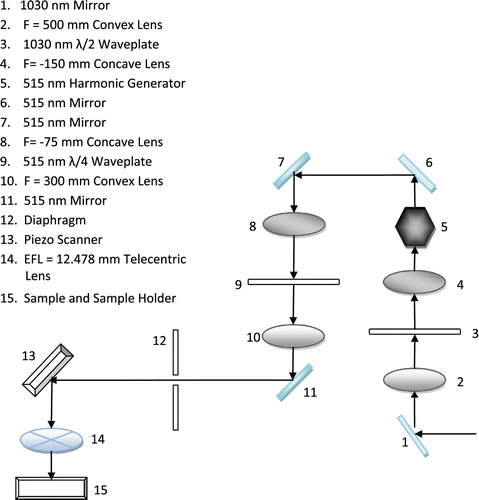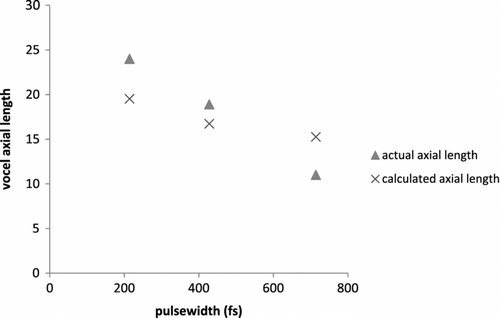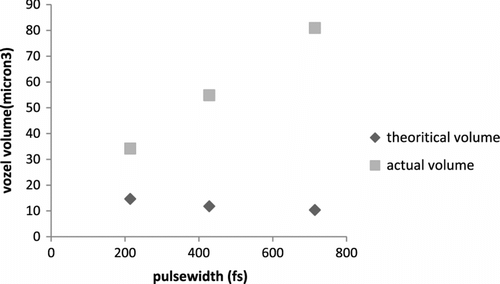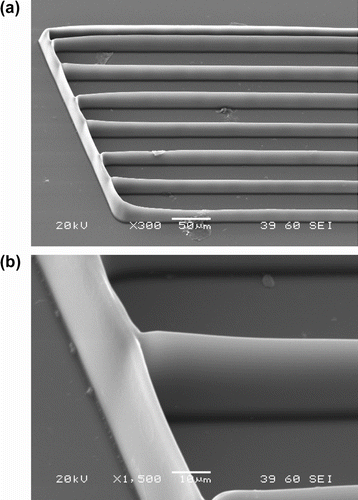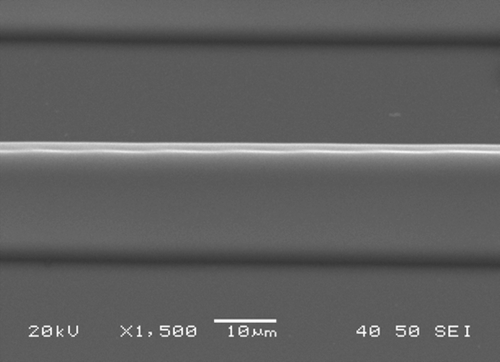Abstract
In this paper, the effect of pulsewidth on two-photon polymerization is reported. Free standing walls of micrometer width were generated using a femtosecond laser irradiation of the highly photosensitive Ormocomp. It was found that at constant laser fluence and a constant number of pulses pulsewidth has great influence on the polymerization process. The volume of the polymerized voxel is linearly proportional to pulsewidth, so is the polymerization threshold fluence; and linewidth increases with the increase of pulsewidth. These phenomena can be explained by the pulsewidth-dependent two-photon cross section and temperature-dependent radical diffusion.
1. Introduction
Multi photon absorption (MPA), in which, an atom or a molecule could interact with multiple photons simultaneously in the same quantum event Citation[1], was first predicated by Maria Göppert-Mayer in 1931. MPA requires a very high density of photon, therefore it was not until 1961 that it first achieved the experimental proof of MPA using a continuous-wave laser source Citation[2]. In the last decade, femtosecond laser advanced dramatically. The ultrashort pulsewidth results in extremely high peak power (in the order of MW and GW), making femtosecond laser an ideal tool for inducing two-photon absorption. Two-photon polymerization based on ultrashort laser irradiation of highly sensitive polymer resin has been investigated intensively.
In recent years, two-photon polymerization (2PP) technique has been developed as an effective tool for direct construction of three-dimensional microfeature and it finds great interest in rapid fabrication of biomedical microdevices. The fabrication process of 2PP is very similar to photolithography. Stereolithography, which utilize a laser beam, is another fabrication process similar to 2PP. Much like photolithography, stereolithography is a planner process and cannot generate true 3D features. To generate 3D features in stereolithography, layers of 2D geometric features are created on different layers and stacked to provide the third dimension. On the other hand, in 2PP the laser can be maneuvered three dimensionally inside a volume of photoresist, thereby it is a volumetric process.
The nonlinear nature of two-photon absorption enables true 3D construction with excellent spatial resolution though direct writing. Various resins and femtosecond lasers have been investigated in order to improve the machining capability of 2PP process Citation[3]. Normally, infrared femtosecond lasers are employed for 2PP with pulsewidth ranging from 100 fs to 1 ps. Laser parameters, such as pulse energy, exposure time, scanning strategies, and repetition rate have been studied to gain a better control of the 2PP process. The current 2PP is capable of fabrication in sub-100 nm resolution and aspect ratio up to 6.7 Citation[4]. Many factors have been found to define and characterize the voxel size and polymerization efficiency. Optics, writing speed, presence of inhibitor, and double bond conversion have been investigated Citation[5–7]. However, no investigation has been done on the influence of pulsewidth on 2PP. In this study, we attempt to find influence of pulsewidth on feature size produced by 2PP.
2 Experimental setup
Experiments were conducted with an all-diode-pumped, direct-diode-pumped Yb-doped fiber oscillator/amplifier system capable of producing laser pulse at repetition rates ranging from 200 kHz to 25 MHz. Average output power is 20 W at a repetition rate of 2 MHz. The pulse width ranges between 250 fs and 10 ps. The central wavelength of the laser beam is measured to be around 1030 nm. All the experimental data were conducted at a repetition rate of 26 MHz and 15 W of average power. An experimental analysis was performed on pulsewidths at 214, 428, and 714 fs. The peak power at these pulsewidths is 2.7, 1.3, and 0.8 MW, respectively.
Figure gives the schematic drawing of the experimental setup. The laser beam diameter is expanded to 8 mm through a combination of a plano-concave lens and a plano-convex lens. The polarization state of the laser beam is rotated to circular by a half wave plate placed in between the two lenses. A harmonic generator is employed to double the laser frequency. The laser beam is then steered to scan across the sample surface using a piezo tip/tilt mirror with a high resonant frequency of 1 kHz. Such high frequency is of great importance to high repetition rate laser machining since precise pulse number control demands for high frequency beam steering. Three scan speeds of 2.5, 5.0, and 10.0 mm/s were used to scan line patterns. Finally, the laser beam passes through a telecentric lens with a 12.478 mm focal length and is focused onto the sample surface. The theoretical laser machining spot diameter is calculated to be 1.02 μm. The actual diameter could be bigger than the theoretical value due to aberration and other errors. The samples are mounted on a two-axis (x and y) translation stage with a precision step of 0.5 μm.
A layer of 25 μm thick Ormocomp (ORMOCOMP®s, Trademark of the Fraunhofer-Gesellschaft zur Forderung der Angewandten Forschung e.V., Munich, Germany) is spin-coated on a silicon substrate. The Ormocomp contains 1% (weight ratio) of BASF® Darocur TPO photoinitiator (2,4,6-trimethylbenzoyl-diphenyl-phosphineoxide). The coated substrate is prebaked in order to ensure that proper adhesion. After being exposed to the laser irradiation, the substrate is then post baked and developed. Free standing wall structures are obtained. The sample evaluation was carried out under a scanning electron microscope (SEM). To increase the conductivity of the polymer structures, samples are gold sputtered before being viewed by SEM.
3 Discussion & results
Polymerization threshold fluence is the minimum pulse energy required to start 2PP process. Threshold fluencies at various pulsewidth were tested at a constant scanning speed, which imply a constant number of pulses. The results are plotted in Figure . The figure shows that threshold fluence increases linearly with the increase of pulsewidth. As will be discussed later, the larger volume size could be used to explain the observed increase in polymerization threshold at longer pulsewidth.
Previous research conducted on two-photon absorption (TPA) of Ormocers revealed that the lowest measured density of radicals required for polymerization of Ormocers is approximately 0.25 wt % Citation[8]. Serbin et al. proposed the model for calculating the density of radicals, ρ(r, t), produced by intense laser pulses by solution of a simple rate equation Citation[9]:
The voxel expansion rate of 2PP is anisotropic. It grows faster along the axial direction than on focal plane. This makes 2PP particularly advantageous for the rapid fabrication of microstructures of high aspect ratio, such as columns and pillars Citation[10]. The polymerized voxel dimension can be defined by the density of activated initiator which is determined by photoresist properties, laser intensity, and pulsewidth. For polymerization to take place the absorbed light intensity must exceed the threshold dose F(L) (in energy per unit area) of a photoresist Citation[11].
where, I p is the peak intensity of the focused optical pulse, N is the number of pulses, L is the thickness of the photoresist, and τ is the pulsewidth.
If ω is the radius of the focused laser spot, the Guassian beam intensity profile on the focal plane I p(ω) is given by
The laser intensity distribution at the axial direction at ω o is given by
The voxel length l in vertical direction starting from the focal plane can be written as
In this study, a scanning beam is used instead of a stationary one. Therefore, the number of pulse N should be replaced with effective number of pulses, N eff, deduced from scan speed, v (m/s) and the repetition rate, f (MHz).
Using Equations (3) and (5), the linewidth and the axial length of the produced feature can be estimated numerically. The TPA coefficient, β is related to TPA cross section, σ 2, through Citation[12]
where, N is the Avogadro’s number, C is the initiator concentration, and hv is the photon energy. However, the TPA cross section for Ormcomp is unknown. Similar product such as Ormocer has a TPA cross section of 3 × 10−5 GM, and with more sensitive photo initiators, cross section as high as 1000 GM is possible Citation[8]. Therefore, the TPA coefficient, β, varies in a very wide range dependent on the properties of photoinitiator. If we assume TPA coefficient, β, under our experimental condition, is around 1 cm/GM, the computed voxel dimensions are good approximations with measured ones. Therefore, for the simplicity of this analysis, we assume β equal to 1 cm/GW and it remains constant within the range of pulsewidth used for this experiment.
Figures and plot the linewidth and axial length at a scaled laser fluence of 1.05 F(L). Due to inaccuracy in the diameter of laser spot and the 2PP coefficient, the calculated dimensions contain large error and should not be used for quantitative analysis. Instead, the calculated can be used for qualitative studies. The calculation shows that the linewidth slightly reduces with the increase of pulsewidth. While the measured linewidth shows an opposite tendency. Along the optical axis the length decreases with the increase of pulsewidth, which agrees well with Equation (8). Figure plots the relation between the pulsewidth and the voxel volume. The figure shows that at a constant exposure time and irradiation dose the actual voxel volume increases linearly with pulsewidth, while the calculated theoretical voxel volume goes by an opposite trend.
Signorini proposed to discriminate three main possible contributions to the TPA cross section: (I) pure coherent TPA; (II) incoherent two-step TPA; (III) TPA giving rise to a population of excited states, followed by a sequential absorption of a third photon Citation[13]. The overall TPA cross -section is the sum from all three contributions. Pure coherent TPA can only be observed at low laser intensity and when pulsewidth is shorter that 10 femtosecond. For most of the femtosecond laser, like the one used for our experiment, pulsewidth ranges from few tens of femtosecond to several hundreds of femtosecond. In this regime, the pure coherent TPA dominates with the two-step TPA is no more negligible, contributing partially to the overall TPA cross section. At nanosecond pulsewidth, process II and III dominate and incoherent excited-state population builds up from which single photon absorption occurs. Thus, short pulsewidth is preferred to maintain the pure coherent TPA, avoid sequential absorption and achieve a smaller TPA cross section, which in turn defines a smaller spatial volume of the polymerized voxel. It is reasonable to deduce that the large discrepancies between calculated voxel dimensions and actual measured voxel dimension are presented in is caused by the assumption of a constant TPA cross section regardless the pulsewidth. In fact, the TPA cross section, σ 2, increases with the increase of pulsewidth, so does the TPA coefficient, β. At longer pulsewidth, a larger β will determine larger voxel diameter and length, therefore, bigger voxel volume. With a bigger voxel volume, more energy is needed in order to generate sufficient radials to reach the threshold density required for polymerization. Therefore, the polymerization threshold fluence increases with the increase of pulsewith, as shown in Figure .
Although TPA cross section gives us insight on the voxel volume, it does not explain why polymerized voxel does not exactly duplicate the focal spot shape and tend to grow faster in the focal plane than in the axial direction.
Immediate after a threshold irradiation, a voxel is formed. The voxel volume is defined by the portion of the laser spot of which the intensity is above the polymerization threshold. If exposure continues after the initial voxel formation, the voxel will continues to grow and the growth is dominated by radical diffusion Citation[14]. The characteristic time of diffusion is in the order of 10 μs Citation[15]. In our experiments, the scanning speed of 2.5 mm/s results in an effective number of pulses of 6517. At a repetition rate of 26 MHz, this means an effective exposure time of 250 μs, long enough for radical diffusion to take place.
Uppal’s simulation shows that there is a small (∼2 K) temperature rise in the resin after a single pulse irradiation, mainly due to light absorption. According to previous study, heat diffusion will transit to heat accumulation at Mega Hertz repetition rate Citation[16]. At a constant laser fluence, the temperature rise due to laser heating is more prominent at longer pulsewidth. As the polymerization threshold increases with the increase of pulsewidth, higher laser energy must be used to solidify the Ormocomp resin, which in turn enhances laser heating. With an effective pulse number of 6517 at a repetition rate of 26 MHz, an appreciable temperature rise in the resin can be expected at the end of the irradiation and the degree of rise is higher at longer pulsewidth. Since radical diffusion is temperature dependent, the laser heating and heat accumulation could be used to explain the observed tendency of linewidth increasing with the increase of pulsewidth. With longer pulsewidth, higher temperature rise can be expected so as faster radical diffusion and the enlargement of the voxel. The growth mainly affects lateral dimension. Along the light propagation direction the voxel length is much larger than the voxel diameter. Therefore, it is less affected by the radical diffusion.
The experimental results show that short pulsewidth is preferred in order to minimize the voxel growth, especially in the lateral direction, and retain the original dimension. Figures and give examples of microfeatures generated at a pulsewidth of 214 fs. In both cases, the wall width is around 2 μm. At a scanning speed of 2.5 mm/s, an aspect ratio more than 10 is achieved.
4 Conclusion
In this research, we conducted an experimental study on the effect of pulsewidth on the feature size of 2PP. Arrays of free standing wall of micrometer width were generated at various pulsewidth at a constant nominalized fluency. It is found that at a large number of pulses with the increase of pulsewidth the width of the wall grows and the height of the wall reduces. The polymerization threshold is linearly proportional to pulsewidth, so is voxel volume. The pulsewidth-dependent TPA cross section is proposed to explain these observations. Temperature-dependent radial diffusion is used to explain the uneven growth of the wall width and wall length. It is concluded that short pulsewidth is advantageous in improving lateral spatial resolution and volumetric resolution.
References
- Göppert-Mayer , M . 1931 . Über Elementarakte mit zwei Quantensprüngen . Annalen der Physik , 9 : 273 – 94 .
- Kaiser , W and Garrett , CGB . 1961 . Two-photon excitation in CaF2: Eu2+ . Physical Review Letters , 7 ( 6 ) : 229 – 31 .
- Lee , KS , Kim , RH , Yang , DY and Park , SH . 2008 . Advances in 3D nano/microfabrication using two-photon initiated polymerization . Progress in Polymer Science , 33 : 631 – 81 .
- Serbin , J . 2003 . Femtosecond laser-induced two-photon polymerization of inorganic organic hybrid materials for applications in photonics . Optics Letters , 28 ( 5 ) : 301 – 3 .
- Cicha , K , Li , Z , Stadlmann , K , Ovsianikov , A , Markut-Kohl , R , Liska , R and Stampfl , J . 2011 . Evaluation of 3D structures fabricated with two-photon-photopolymerization by using FTIR spectroscopy . Journal of Applied Physics , 110 : 064911
- Wang , X , He , J , Ma , J , Ding , J , Chu , J and Huang , W . 2011 . Resolution improvement of femtosecond laser induced two-photon polymerization based on phase filtering . Optical Engineering , 50 ( 5 ) : 054302
- Maruo , S and Ikuta , K . 2000 . Three-dimensional microfabrication by use of single-photon-absorbed polymerization . Applied Physics Letters , 76 ( 19 ) : 2656 – 8 .
- Teh , WH , Durig , U , Drechsler , U , Smith , CG and Guntherodt , HJ . 2005 . Effect of low numerical-aperture femtosecond two-photon absorption on (SU-8) resist for ultrahigh-aspect-ratio microstereolithography . Journal of Applied Physics , 97 ( 5 ) : 054907
- Lee , CH , Chang , TW , Lee , KL , Lin , JY and Wang , J . 2004 . Fabricating high-aspect-ratio sub-diffraction-limit structures on silicon with two-photon photopolymerization and reactive ion etching . Applied Physics A , 79 ( 8 ) : 2027 – 31 .
- Ovsianikov , A , Chichkov , B , Mente , P , Monteiro-Riviere , NA , Doraiswamy , A and Narayan , RJ . 2007 . Two photon polymerization of polymer-ceramic hybrid materials for transdermal drug delivery . International Journal of Applied Ceramics Technology , 4 : 22 – 9 .
- Sun , HB , Takada , K , Kim , MS , Lee , KS and Kawata , S . 2003 . Scaling laws of voxels in two-photon photopolymerization nanofabrication . Applied Physics Letters , 83 ( 6 ) : 1104 – 6 .
- Signorini , R , Ferrante , C , Pedron , D , Zerbetto , M , Cecchetto , E , Slaviero , M , Fortunati , I , Collini , E , Bozio , R , Abbotto , A , Beverina , L and Pagani , GA . 2008 . Effective two-photon absorption cross section of heteroaromatic quadrupolar dyes: dependence on measurement technique and laser pulse characteristics . Journal of Physical Chemistry , 112 : 4224 – 34 .
- Houbertz , R . 2005 . Laser interaction in sol–gel based materials—3-D lithography for photonic applications . Applied Surface Science , 247 : 504 – 12 .
- Shah , L , Arai , AY , Eaton , SM and Herman , PR . 2005 . Waveguide writing in fused silica with a femtosecond fiber laser at 522 nm and 1 MHz repetition rate . Optics Express , 13 ( 6 ) : 1999 – 2006 .
- Uppal , N and Shiakolas , PS . 2008 . Modeling of temperature-dependent diffusion and polymerization kinetics and their effects on two-photon polymerization dynamics . Journal of Micro/Nanolithography, MEMS, and MOEMS , 7 ( 4 ) : 043002
- Eaton SM, Zhang H, Ng ML, Li J, Chen WJ, Ho S, Herman PR. Transition from thermal diffusion to heat accumulation in high repetition rate femtosecond laser writing of buried optical waveguides. Optics Express. 16(13):9443–58.
